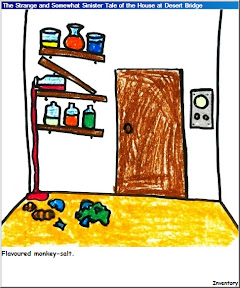The other day, I stumbled on a delightful little adventure game called The Strange and Somewhat Sinister Tale of the House at Desert Bridge by Jonas Kyratzes and friends. “Delightful” really is the right word, as it suggests something simple and childlike yet elegant and charming. Desert Bridge fits this perfectly, and is surprisingly sophisticated to boot.
 |
On first impression, the whole game feels playful and offbeat. All of the graphics are sketched in crayon with a passion for colour and oddity rivaling that of a six year old. All the characters and spaces are slightly kooky, from the cat who believe he’s an emperor, to the spider-pig, the cuddly dinosaur in the garden, the collection of stoned mushrooms in the pantry, the giant hamsters, to Horaffe, the bionic giraffe. Coupled with all of this, the soundtrack really wouldn’t be out of place in some sort of clay-mation mystery adventure.
To some extent, all of this makes the game seem like it must be targeted at children, but it’s really not. The humour’s quite sophisticated and sometimes subtle, there’s a distinct hint of sadness throughout, and without giving away the ending, let me just mention that the word ‘sinister’ in the title doesn’t mean that everyone is left handed.
For the geeky, the game’s also riddled with references to geek culture, from Bill & Ted, to Fallout, to Zathras, a turtle that speaks, well, like Zathras (from Babylon 5). Furthermore, pretty much everything you can interact with is either funny, a pun, or just plain outlandish. Examples include flavoured monkey salt, polyhedrix asparagus extract, orange wolf honey, or liquid salami (and that’s just one room).
On a gameplay level, it’s your average point and click adventure – move from room to room, talk to people, click on objects, pick them up and merge to form other objects. It’s even got a ‘golden hammer’ puzzle; that is, a puzzle gimmick that gets re-used again and again, if only you realize that something’s a reference to it.
One of the nice things about the crayon graphics is that each of the scenes has less extraneous detail than many adventure games. If you can see something, it’s worth clicking on it, and if something can be clicked on, you can see it, as all of the objects are reasonably big and contrast well with the background. If I had one criticism for the game, though, it would be that you move by clicking at the edge of the graphics. Consequently, I would often try to click on something and instead, to my mild annoyance, be moved to the next area.
It’s actually just fun to wander around it and poke at things, though, which reminds me a lot of good interaction fiction where everything is worth tampering with, even if it doesn’t mean you’re making any progress. Incidentally, I recommend trying every possible action on everything you pick up. You never know what you might be able to gerbelize.
Difficulty is comparatively low – most of the puzzles are either straight forward or just require a cup of tea and maybe a re-read of some piece of text to solve. Incidentally, there’s quite a lot of text which, though well worth reading, does take a while and, if you’re impatiently charging through like I did the first time around, can seem a burden. But, if you slow down a little and put a little effort into appreciation, it really serves to bring out the characters, particularly Old Man Bill, around whom the story revolves, but who you never meet.
Takes about two hours to play if you’re taking your time, more if you’re obsessively trying things out. Quite unique, but if I had to characterize it in terms of other things, I’d put it somewhere between Zork, anything by Jim Henson, and the walls at your local kindergarten.
Play this game!
![[ meme – hazard ]](http://www.meme-hazard.org/blog/wp-content/uploads/2016/11/mh_banner.png)